Ever wondered why some online stores seem to convert visitors into customers like magic, while others struggle despite having great products? The secret ingredient isn’t always what you’re selling—it’s whether customers trust you enough to buy.
In a world where anyone can set up an online store in minutes, trust has become the ultimate currency. Think about it: when was the last time you confidently entered your credit card details on a website that felt sketchy? Probably never. And your customers feel exactly the same way.
This comprehensive guide will take you behind the scenes of e-commerce trust building—from the psychology that drives customer confidence to cutting-edge techniques that signal reliability. By the time you finish reading, you’ll understand:
- The hidden psychological triggers that make customers trust (or distrust) your store
- Practical trust signals that transform skeptical visitors into confident buyers
- Advanced social proof systems that leverage human psychology
- How to build unshakable authority in your niche
- Crisis-proof strategies to maintain trust even when things go wrong
Ready to build an e-commerce brand that customers instinctively trust? Let’s dive in!
Foundational Pillars of E-commerce Trust
Before we explore specific techniques, we need to understand what trust actually is in the digital commerce world. This foundation will help you implement strategies with purpose rather than just following a checklist of best practices.
The Trust Equation in Digital Commerce
Trust isn’t just a feeling—it can be broken down into a formula that helps us understand its components:
Trust = (Credibility + Reliability + Intimacy) ÷ Self-Interest
Let’s break this down:
- Credibility: Do you appear knowledgeable and truthful? This comes from professional design, accurate information, and demonstrated expertise.
- Reliability: Do you consistently deliver on promises? This includes accurate shipping times, product quality matching descriptions, and responsive customer service.
- Intimacy: Can customers connect with your brand emotionally? This involves sharing your story, values, and creating personal connections.
- Self-Interest: How much do customers feel you’re focused on your gain versus helping them? The lower your perceived self-interest, the higher the trust.
When building your e-commerce trust strategy, aim to strengthen the numerator elements while minimizing perceived self-interest. For example, offering helpful buying guides (not just pushing products) decreases perceived self-interest while increasing credibility.
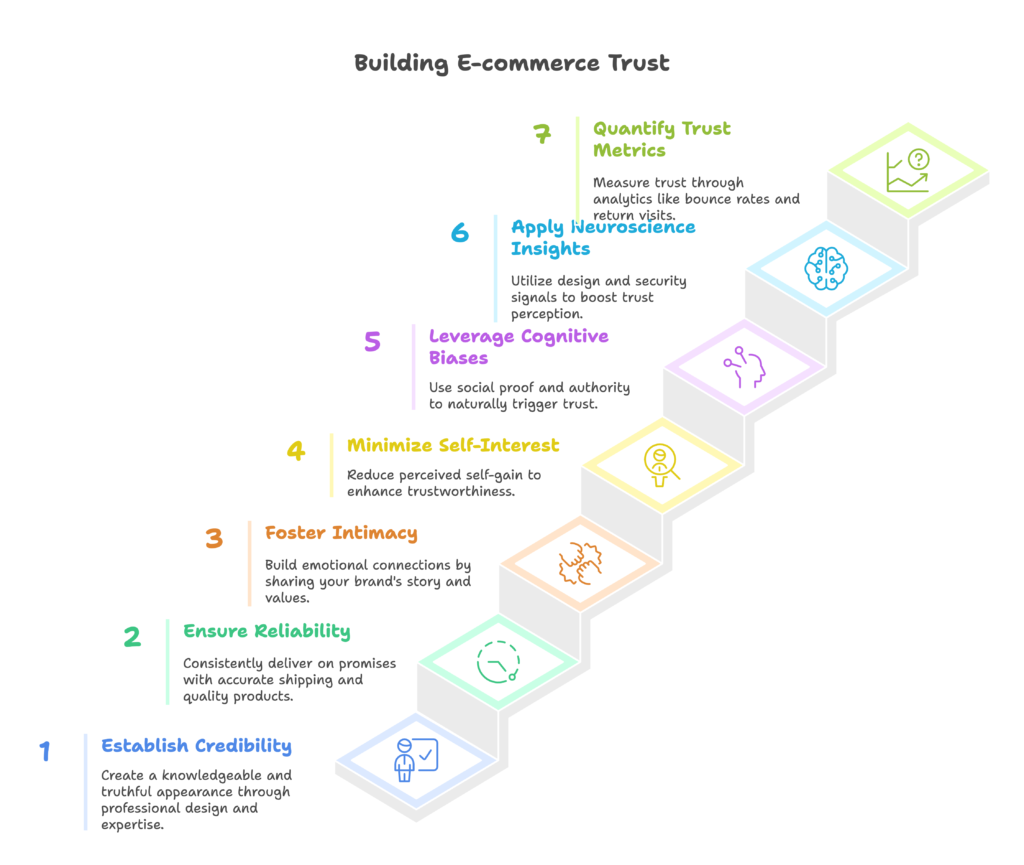
Cognitive Biases Impacting Online Trust Formation
Our brains use shortcuts to decide who to trust, especially in unfamiliar online environments. Understanding these biases helps you design a store that naturally triggers trust:
- Social proof bias: We trust what others appear to trust (which is why reviews and testimonials work so powerfully)
- Authority bias: We trust entities that demonstrate expertise or official recognition
- Consistency bias: We trust experiences that match our expectations and prior knowledge
- Loss aversion: We fear losing money more than we desire gaining value (which is why guarantees are effective)
- Aesthetic-usability effect: We perceive visually appealing designs as more trustworthy and usable
By designing your store with these biases in mind, you can create an environment that naturally feels trustworthy to visitors without them even realizing why.
The Neuroscience of Brand Credibility Perception
When a customer lands on your site, their brain processes trust signals at lightning speed, often before conscious thought kicks in:
- Visual cortex processes design quality within 50 milliseconds
- Amygdala activates with perceived risk signals (like security concerns)
- Ventral striatum responds to positive trust signals (like recognized certifications)
- Prefrontal cortex evaluates logical trust evidence (like transparent policies)
This is why seemingly small details—like using standard navigation patterns or displaying security badges—have outsized impacts on trust. They work with, not against, the brain’s natural trust evaluation system.
Quantifying Trust Through Behavioral Analytics
Trust isn’t just a fuzzy concept—it can be measured through specific user behaviors:
- Bounce rate on crucial pages: High abandonment on product or checkout pages often signals trust issues
- Depth of content engagement: Visitors who read policies, about pages, and detailed product information are evaluating trustworthiness
- Cart abandonment patterns: Abandonment after seeing shipping costs or at payment often indicates trust barriers
- Return visitor rate: Customers who return directly (not via search) demonstrate established trust
- Willingness to provide information: Subscription to newsletters or creation of accounts indicates baseline trust
By tracking these metrics, you can identify specific trust hurdles in your customer journey and target improvements where they matter most.
Now that we understand how trust works psychologically, let’s examine the specific signals that build trust in the minds of your visitors. These aren’t just theoretical—they’re practical elements you can implement starting today!
The Trust Signal Hierarchy
Not all trust signals are created equal. In this section, we’ll explore the hierarchy of trust signals from foundational must-haves to advanced differentiators, so you can prioritize your trust-building efforts effectively.
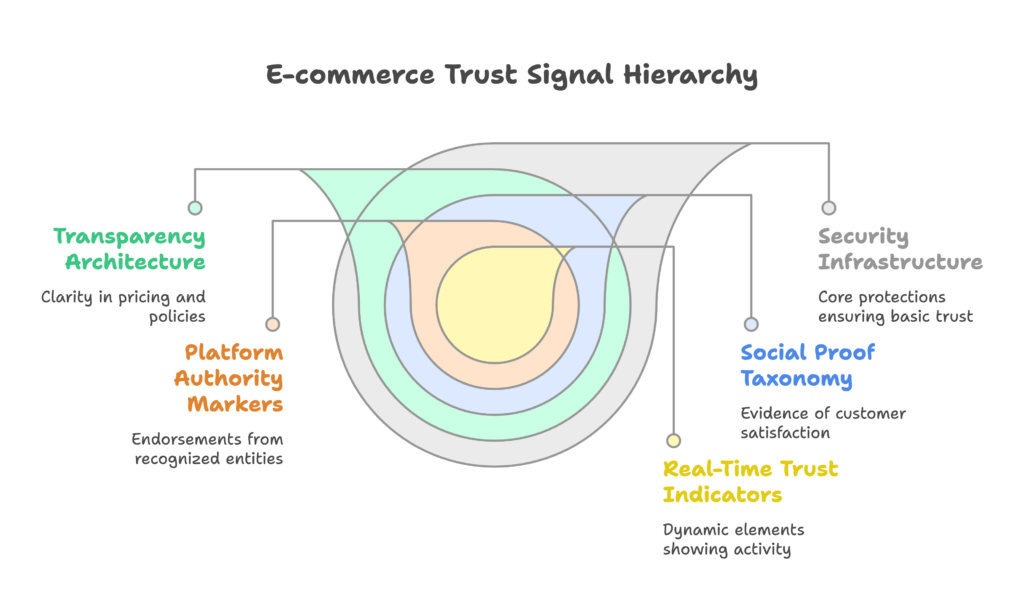
Security Infrastructure as Primary Trust Anchors
Security forms the foundation of e-commerce trust—without it, nothing else matters. The primary signals include:
- HTTPS/SSL certification: The padlock icon in browsers is now a basic expectation, not a differentiator. Ensure your entire site (not just checkout) is secured.
- PCI DSS compliance: Display badges indicating you follow payment card industry security standards.
- Secure payment icons: Familiar payment methods (PayPal, major credit cards) serve as trust shortcuts.
- Privacy policy accessibility: Make your data handling practices clear and easy to find.
- GDPR/CCPA compliance: Demonstrate respect for privacy regulations with compliant cookie notices and data requests options.
These signals don’t necessarily boost trust dramatically, but their absence creates immediate distrust. Think of them as the entry ticket to the e-commerce trust game.
Transparency Architecture – From Pricing to Supply Chain Disclosure
After security, transparency forms the next layer of trust. Modern consumers expect clarity on:
- All-inclusive pricing: Show taxes and shipping costs early in the shopping process
- Return and refund policies: Clear, fair policies without hidden conditions
- Product sourcing: Information about manufacturing, ingredients, or origins
- Company location and contact: Real physical address and multiple contact methods
- Shipping timelines: Honest delivery estimates with regular updates
Research shows that revealing potential negatives (like longer shipping times for certain products) actually increases trust more than hiding them. Transparency creates confidence, even when the news isn’t perfect.
Social Proof Taxonomy – Progressive Trust Building Layers
Social proof—evidence that others trust and value your products—comes in multiple forms that build upon each other:
- Level 1: Usage statistics – “10,000+ happy customers” or “Over 50,000 products shipped”
- Level 2: Star ratings and review counts – Aggregate feedback shown prominently
- Level 3: Detailed customer reviews – Complete with photos, verified purchase badges, and specific details
- Level 4: Customer stories and case studies – In-depth narratives of customer experiences
- Level 5: Community content – User-generated content showcasing product usage
The more personal and detailed the social proof, the stronger its trust impact. A single detailed video review often carries more weight than dozens of simple star ratings.
Platform Authority Markers – Certifications, Awards & Media Mentions
Authority signals borrow trust from established institutions and publications:
- Industry certifications: Symbols of quality standards (e.g., USDA Organic, Fair Trade)
- Business accreditations: BBB ratings or Chamber of Commerce memberships
- Media mentions: “As seen in” sections featuring recognizable publications
- Awards and recognitions: Industry awards or “Best of” listings
- Partner logos: Business relationships with trusted entities
Display these prominently but selectively—too many badges create visual noise and dilute impact. Prioritize the most recognizable and relevant to your specific audience.
Real-Time Trust Indicators – Stock Levels, Live Visitor Counts
Dynamic elements that show your store is active and used by others create urgency while building trust:
- Inventory counters: “Only 5 left in stock” creates both urgency and believability
- Recent purchase notifications: “Jane from California just purchased this item”
- Live visitor indicators: “15 people are viewing this product right now”
- Real-time customer service status: “Support agents currently available”
- Updated “last ordered” timestamps: Shows recent, ongoing activity
These dynamic elements work best when they’re authentic—fake urgency is easily spotted and destroys trust. Use actual data or don’t use these indicators at all.
With the basic trust signals established, let’s explore more sophisticated social proof strategies that take customer confidence to the next level. These approaches separate the trust leaders from the merely adequate stores.
Advanced Social Proof Systems
Basic reviews and testimonials are just the beginning. In this section, we’ll explore sophisticated social proof strategies that create powerful confidence in potential buyers’ minds.
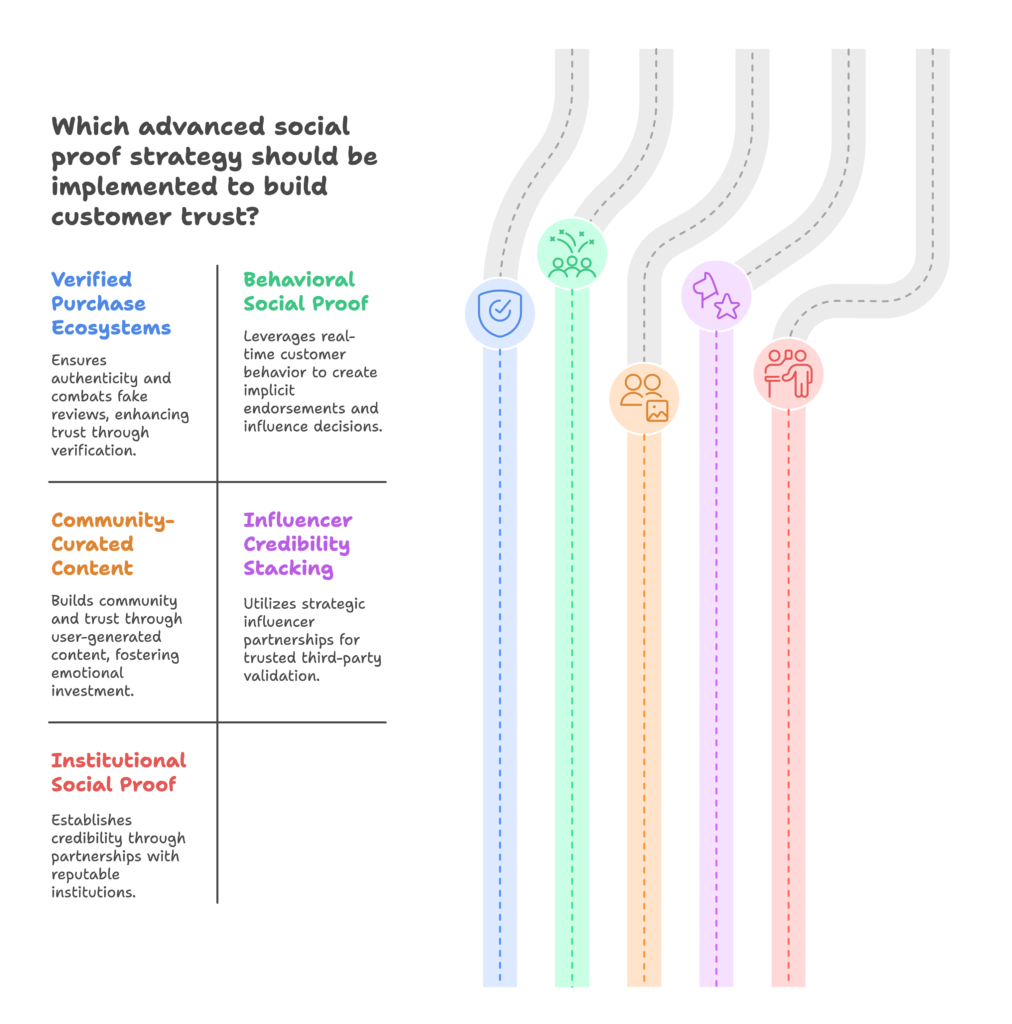
Verified Purchase Ecosystems – Combating Fake Reviews
In an era of widespread review skepticism, verification systems make your social proof believable:
- Verified purchase badges: Clear indicators that reviewers actually bought the product
- Review invitations tied to order numbers: Systematically request reviews after confirmed delivery
- Review authenticity guarantees: Public policies against incentivized or manipulated reviews
- Balanced review distribution: All positive reviews appear as suspicious as all negative ones
- Review response systems: Show that you actively engage with feedback, especially criticism
Studies show that customers actually trust stores with some negative reviews more than those with perfect scores, as it indicates authenticity. The key is how you respond to criticism—thoughtful responses to negative reviews can actually build more trust than the negative review loses.
Behavioral Social Proof – Live Activity Feeds & Heatmaps
Showing real-time customer behavior creates powerful implicit endorsements:
- Popular product indicators: “Trending now” or “Most viewed” labels based on actual data
- Purchase activity feeds: Tasteful notifications of recent orders
- Wishlisting metrics: “Added to 50+ wishlists this week”
- Product interaction stats: “2,000+ people have viewed this product today”
- Category popularity heatmaps: Visual indicators of most-browsed sections
These signals work because they tap into what behavioral economists call “information cascades”—our tendency to follow others’ lead when making decisions under uncertainty.
Community-Curated Content Strategies
User-generated content creates authentic social proof while building community:
- Customer photo galleries: Real images of products in use by actual customers
- Usage demonstration videos: Customer-created tutorials and reviews
- Social media integration: Curated feeds of customers using products
- Community Q&A sections: Fellow customers answering potential buyers’ questions
- Product idea submissions: Customer involvement in future product development
This approach not only builds trust but creates emotional investment in your brand. Customers who contribute content become advocates and feel a sense of ownership in your success.
Influencer Credibility Stacking Techniques
Strategic influencer partnerships can provide trusted third-party validation:
- Micro-influencer networks: Multiple smaller, highly-trusted voices instead of one major celebrity
- Category expert endorsements: Subject matter authorities within your niche
- Long-term influencer relationships: Sustained partnerships over one-off promotions
- Behind-the-scenes development involvement: Influencers who helped create or test products
- Transparent sponsorship disclosure: Clear identification of paid versus organic mentions
The key here is authenticity—modern consumers can spot inauthentic endorsements instantly. The most effective influencer relationships involve genuine product users who maintain their credibility by being selective about partnerships.
Institutional Social Proof – Partnerships & Academic Endorsements
Relationships with established institutions transfer their credibility to your brand:
- Academic research collaborations: University studies supporting product claims
- Professional association endorsements: Industry group approvals or memberships
- NGO partnerships: Collaborations with respected non-profits in your field
- Government or regulatory recognition: Compliance with or exceeding official standards
- Major corporate client showcases: B2B relationships with known companies
These institutional relationships often take longer to develop but create powerful, lasting trust foundations that competitors can’t easily replicate.
Now that we’ve covered social proof, let’s explore how to establish yourself as a respected authority in your niche—a status that creates automatic trust before customers even see your products.
Authority Architecture
Establishing your brand as an authority does more than build trust—it creates a presumption of quality that influences every customer interaction. Let’s explore how to systematically build authority in your niche.
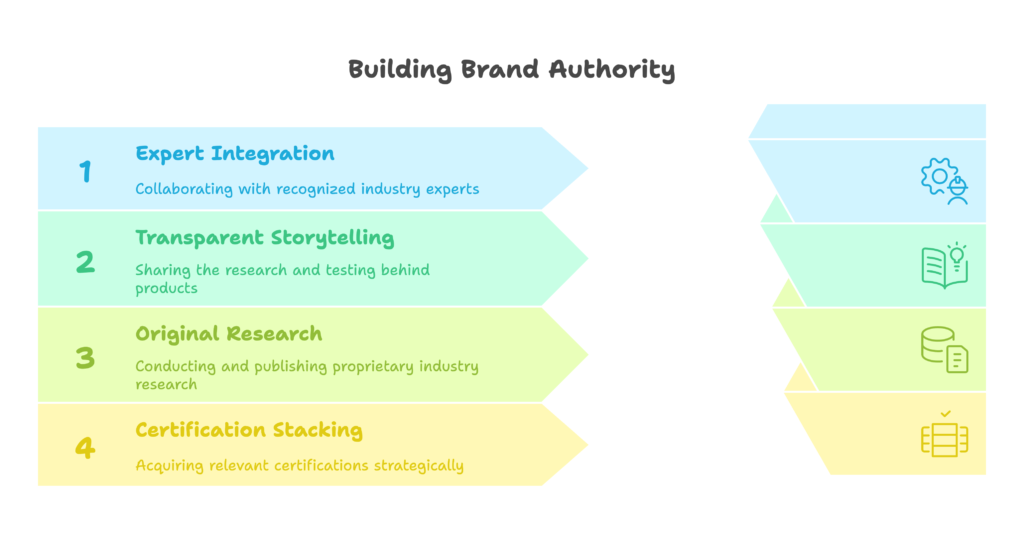
Content Authority Mapping – E-A-T Optimization
Search engines and consumers both evaluate content based on Expertise, Authoritativeness, and Trustworthiness (E-A-T). Build your authority through content that demonstrates:
- Deep subject matter expertise: Comprehensive guides and resources beyond basic product information
- Original insights and analysis: Fresh perspectives on industry trends and challenges
- Factual accuracy and citation: Well-researched claims with proper sourcing
- Currency and updates: Regularly refreshed content that reflects latest developments
- Appropriate credentialing: Clear attribution of content to qualified team members
Map your content strategy to systematically demonstrate authority across all major topics relevant to your products and customer needs. The goal is to become the go-to resource in your niche.
SME (Subject Matter Expert) Integration Strategies
Associating your brand with recognized experts creates powerful authority by association:
- Expert advisory boards: Formal relationships with industry authorities
- Specialist content contributors: Guest articles from recognized experts
- Product development collaborations: Expert input in creating or improving offerings
- Expert Q&A sessions: Live events or recorded interviews with authorities
- Professional certification programs: Training or accreditation from industry organizations
Make these relationships prominent and substantive. Token associations are easily spotted and can backfire, but meaningful expert involvement signifies confidence in your products’ quality.
Research-Backed Product Development Storytelling
Sharing the research and testing behind your products builds authority through transparency:
- Development journey documentation: The evolution from concept to final product
- Testing protocols and results: Objective measures of performance and quality
- Comparative analyses: How your products stack up against alternatives
- Customer feedback integration: How user input shaped improvements
- Scientific foundations: Research that informed product design decisions
This approach works particularly well for technical products, supplements, skincare, and other categories where performance claims require substantiation. It transforms skepticism into confidence by showing your commitment to evidence-based development.
Industry Leadership Positioning Through Original Data
Creating and sharing original research establishes unmatched authority:
- Proprietary industry surveys: Market research you conduct and publish
- Benchmark reports: Comparative analyses across your category
- Trend analysis publications: Forward-looking insights based on your data
- White papers and case studies: Deep dives into specific problems and solutions
- Open data initiatives: Sharing anonymized datasets to benefit the industry
By publishing original data, you position yourself not just as a seller but as a knowledge leader that shapes industry conversation. This creates a powerful authority halo that influences how customers perceive everything else about your brand.
Certification Stacking – Building Credibility Portfolios
Strategic acquisition of relevant certifications creates cumulative authority:
- Product quality certifications: Industry-specific seals of approval
- Process certifications: Standards compliance for manufacturing or fulfillment
- Environmental/ethical certifications: Sustainability and responsibility credentials
- Security certifications: Advanced data protection standards
- Professional accreditations: Team member qualifications and continuing education
Rather than pursuing random certifications, develop a strategic “certification stack” that addresses your specific customers’ chief concerns. For example, a skincare brand might prioritize certifications around ingredient purity, ethical testing, and dermatological validation.
With authority established, let’s explore how familiarity builds trust over time through consistent experiences across every customer touchpoint.
The Familiarity-Trust Feedback Loop
Psychological research shows that familiarity breeds trust—we inherently feel more comfortable with what we recognize. This section explores how to create a positive feedback loop where familiarity increases trust, which in turn increases familiarity.
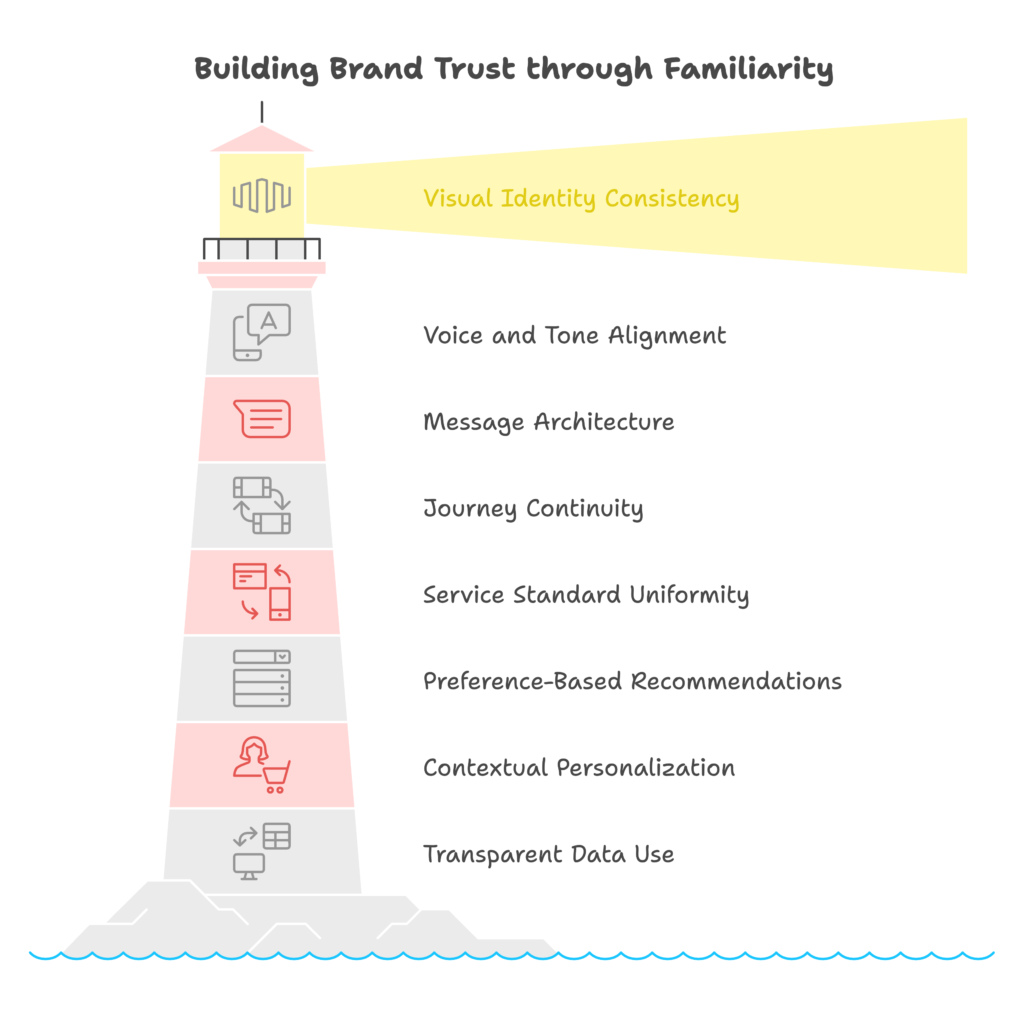
Cross-Channel Brand Consistency Frameworks
Consistent experiences across touchpoints reinforce recognition and reliability:
- Visual identity consistency: Cohesive colors, typography, and imagery across platforms
- Voice and tone alignment: Recognizable communication style in all content
- Message architecture: Consistent value propositions and key messages
- Customer journey continuity: Seamless transitions between channels (social→email→site)
- Service standard uniformity: Reliable experience regardless of contact method
Develop a comprehensive brand guidelines document that ensures consistency not just in logos and colors, but in every aspect of customer experience. The goal is instant recognition regardless of where customers encounter your brand.
Predictive Personalization Without Creep Factor
Personalization builds familiarity when it feels helpful rather than invasive:
- Preference-based recommendations: Suggestions based on explicit choices
- Contextual personalization: Adapting to current shopping scenario rather than past data
- Transparent data use: Clear explanations of why recommendations are shown
- Progressive personalization: Increasing personalization as relationship develops
- Control and opt-out options: Giving customers agency over their experience
The best personalization feels like good service rather than surveillance. Focus on creating genuinely helpful experiences that make customers feel understood rather than tracked.
Memory Anchoring Through Design Systems
Strategic design elements create strong memory associations:
- Distinctive visual assets: Unique illustrations, patterns, or icons
- Consistent micro-interactions: Recognizable animations and feedback
- Signature packaging elements: Memorable unboxing experiences
- Brand-specific terminology: Distinctive names for products or features
- Sensory branding: Consistent use of sound, touch, or even scent
The most trusted brands have “memory hooks” that create instant recognition. Think of unboxing an Apple product or hearing Netflix’s signature sound—these anchors trigger familiarity and the associated trust.
Cognitive Fluency Optimization
Making interactions effortlessly understandable increases both trust and satisfaction:
- Intuitive navigation patterns: Using established conventions for site structure
- Progressive disclosure: Revealing information in manageable chunks
- Clear information hierarchy: Obvious visual cues about importance
- Simplified language: Plain communication without unnecessary jargon
- Predictable interaction patterns: Consistent behavior across the site
The easier something is to process mentally, the more we trust it. This is why familiar layouts and expected functionality create confidence, while novel approaches can create uncertainty.
Repetition Cadence Balancing
Strategic repetition reinforces familiarity without becoming annoying:
- Key message frequency: Consistent core messages across touchpoints
- Remarketing thresholds: Optimal frequency for ad exposures
- Content repurposing strategy: Reformatting core ideas across channels
- Touchpoint sequencing: Thoughtful progression of communications
- Seasonal reactivation plans: Renewing connections at appropriate intervals
Find the balance between staying top-of-mind and becoming background noise. Varied repetition (same message, different format) typically works better than identical repetition.
Now that we understand how to build familiarity, let’s explore how the messengers who deliver your brand story can dramatically impact trust levels.
The Messenger Effect Matrix
In trust building, who delivers your message often matters as much as the message itself. This section explores how to leverage different messengers for maximum credibility.
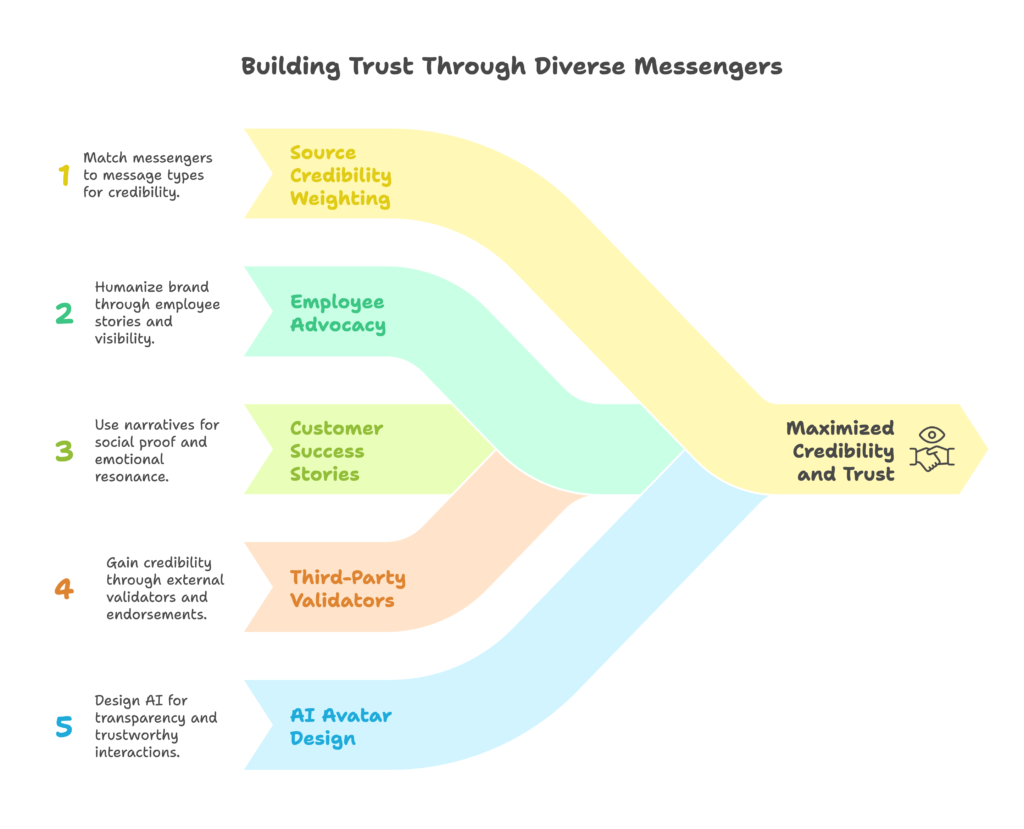
Source Credibility Weighting Algorithms
Different types of messengers carry different levels of inherent trust for specific messages:
- Technical information: Engineers, scientists, and certified professionals
- User experience: Everyday customers with relatable situations
- Quality assurance: Quality control experts and testing facilities
- Value propositions: Industry analysts and comparison experts
- Ethical claims: Independent certification bodies and watchdog organizations
Match your messenger to your message type for maximum credibility. For example, sustainability claims from a third-party environmental organization carry more weight than the same claims from your marketing team.
Employee Advocacy Trust Multipliers
Your team members can be your most powerful trust ambassadors:
- Founder/leader visibility: Putting faces to the company leadership
- Team expert showcasing: Highlighting specialized knowledge within your staff
- Behind-the-scenes content: Authentic glimpses into company culture
- Personal social sharing: Employee ambassadorship on individual channels
- Direct customer engagement: Named team members handling support
Customers trust real people more than faceless corporations. Humanizing your brand through employee stories creates both familiarity and authenticity that corporate communications alone can’t achieve.
Customer Success Story Orchestration
Strategic customer narratives provide powerful social proof:
- Problem-solution narratives: Stories that mirror prospective customers’ challenges
- Outcome documentation: Concrete results achieved with your products
- Diverse customer representation: Stories covering various customer segments
- Progressive journey mapping: From initial skepticism to enthusiastic advocacy
- Video testimonials: High-impact visual storytelling from customers
The most effective customer stories follow a classic narrative arc: challenge, struggle, discovery, implementation, and transformation. This structure resonates emotionally while providing practical proof of your solutions’ effectiveness.
Third-Party Validator Ecosystems
External validators provide objective credibility that self-promotion cannot:
- Industry analysts and researchers: Expert evaluations of your category
- Media reviewers and journalists: Independent product assessments
- Professional associations: Industry group recognition and endorsement
- Certification bodies: Official verification of claims and standards
- Consumer advocacy organizations: Public interest group evaluations
Develop strategic relationships with relevant third-party validators in your industry and make their endorsements highly visible. Even constructive criticism from respected third parties can build trust by demonstrating transparency.
AI Avatar Credibility Engineering
If using AI assistants, design them to maximize trustworthiness:
- Appropriate expertise boundaries: Clear communication about capabilities and limitations
- Transparent AI identification: Honest disclosure of non-human status
- Consistent personality traits: Coherent character that builds familiarity
- Human escalation pathways: Easy transitions to human support when needed
- Progressive intelligence application: Focusing AI on tasks where it excels
The most trusted AI assistants don’t pretend to be human—they provide consistent, helpful service with clear parameters about their nature and capabilities.
With strong messengers established, let’s explore how to verify and prove your trustworthiness through systematic transparency.
Trust Verification Systems
In today’s skeptical market, claims require verification. This section explores systems that allow customers to independently confirm your trustworthiness.
Blockchain-Based Transparency Ledgers
Blockchain technology enables unprecedented supply chain and authenticity verification:
- Product origin tracking: Verified sourcing from raw materials to finished product
- Authenticity verification: Proof against counterfeiting for luxury or critical items
- Ethical practice confirmation: Documented fair labor and sustainable practices
- Ownership records: Permanent proof of purchase for valuable items
- Transparent pricing breakdown: Visible value chain showing cost components
While blockchain implementation requires technical investment, it creates unmatched transparency for industries where provenance, authenticity, or ethical sourcing are key trust factors.
Real-Time Verification Badges
Dynamic trust markers provide current, not historical, verification:
- Live security status indicators: Current security compliance status
- Real-time review verification: Up-to-date confirmation of review authenticity
- Dynamic inventory accuracy: Live stock level verification
- Current certification status: Automatically updated compliance badges
- Active customer service monitoring: Present support performance metrics
Unlike static trust badges, these dynamic indicators reflect your current status, not past achievements, creating ongoing accountability and transparency.
Independent Review Audits
Third-party verification of review authenticity builds meta-trust:
- External review verification: Independent confirmation of review processes
- Review policy transparency: Clear documentation of how reviews are collected
- Statistical review analysis: Pattern detection to identify manipulation
- Verified reviewer identification: Confirmation of reviewer legitimacy
- Open review data access: Making review data available for independent analysis
As consumers grow increasingly skeptical of online reviews, independent verification creates confidence in your social proof. Services like Trustpilot and Feefo provide this external validation.
User-Controlled Data Dashboards
Giving customers control over their data builds privacy trust:
- Transparent data collection views: Clear visibility into what data is gathered
- Preference control centers: Granular options for privacy settings
- Data export capabilities: Ability to download personal information
- Usage analytics access: Insights into how data informs experiences
- Deletion verification: Confirmation of data removal upon request
In a privacy-conscious world, demonstrating respect for customer data through transparency and control creates significant trust advantages.
Crowdsourced Quality Assurance Networks
Engaging customers in product validation creates community and confidence:
- Beta testing programs: Customer involvement in pre-release testing
- Community product challenges: Public tests of durability or performance claims
- Open feedback platforms: Transparent collection and response to input
- Comparative testing initiatives: Side-by-side evaluations with competitors
- User-generated testing content: Customer-created verification of claims
When customers themselves become part of your quality verification process, their investment creates advocacy while their findings build broader market trust.
Even with the strongest trust foundation, challenges will arise. Let’s explore how to maintain trust through inevitable difficulties.
Crisis-Proof Trust Infrastructure
Trust is tested not in good times but in challenges. This section explores how to build trust resilience that can withstand inevitable setbacks.
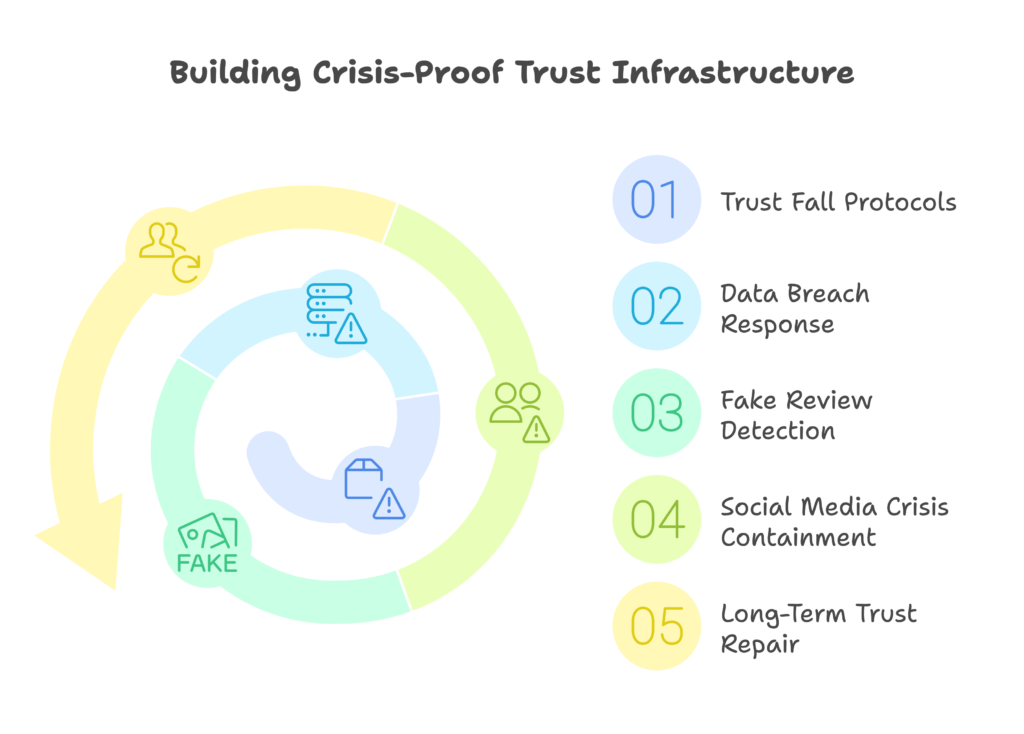
Trust Fall Protocols – Handling Product Failures
How you handle product issues often builds more trust than having no issues at all:
- Early warning systems: Proactive identification of potential problems
- Transparent communication templates: Ready-to-use crisis messaging frameworks
- Clear escalation pathways: Defined process for problem resolution
- Fair compensation standards: Consistent remediation for affected customers
- Root cause commitment: Demonstrated investment in preventing recurrence
Research shows that customers whose problems are well-handled often become more loyal than those who never experienced problems. The key is having systems in place before issues arise.
Data Breach Response Frameworks
Prepared response to security incidents minimizes trust damage:
- Incident containment protocols: Immediate steps to limit exposure
- Transparent disclosure timing: Prompt, appropriate customer notification
- Impact assessment communication: Clear explanation of what was affected
- Remediation support: Assistance for affected customers
- Preventative improvement documentation: Visible security enhancements
Data breaches damage trust, but incomplete or delayed response destroys it. Having a prepared, practiced framework ensures you can maintain trust through security challenges.
Fake Review Detection Systems
Protecting review integrity preserves social proof credibility:
- Algorithmic pattern recognition: Automated detection of suspicious review patterns
- Verified purchase flags: Clear identification of confirmed buyers
- Review moderation standards: Transparent policies on review acceptance
- IP and account verification: Technical measures to prevent manipulation
- Review response governance: Guidelines for addressing suspicious reviews
As fake reviews become more sophisticated, demonstrating your commitment to authentic feedback becomes increasingly important for maintaining customer trust.
Social Media Crisis Containment
Prepared response to public criticism prevents viral trust damage:
- Monitoring and alert systems: Early detection of emerging issues
- First-response frameworks: Guidelines for immediate acknowledgment
- Escalation criteria: Clear thresholds for different response levels
- Accountability communication: Templates for taking responsibility
- Learning demonstration: Public commitment to improvement
The speed and tone of your initial response often determines whether a social media problem becomes a minor blip or a major crisis. Having prepared frameworks ensures you respond appropriately even under pressure.
Long-Term Trust Repair Strategies
Systematic approach to rebuilding damaged trust:
- Root cause transparency: Honest explanation of what went wrong
- Visible corrective actions: Demonstrable changes to prevent recurrence
- Consistent follow-through: Long-term commitment to improvement
- Independent verification: Third-party confirmation of changes
- Progressive trust rebuilding: Step-by-step restoration of confidence
Trust recovery takes longer than trust building. The key is patience and consistency—demonstrating through sustained action, not just words, that the underlying issues have been addressed.
With crisis preparation in place, let’s explore how to measure and optimize trust through data-driven approaches.
Trust Analytics & Optimization
You can’t improve what you don’t measure. This section explores methodologies for quantifying and optimizing trust through data.
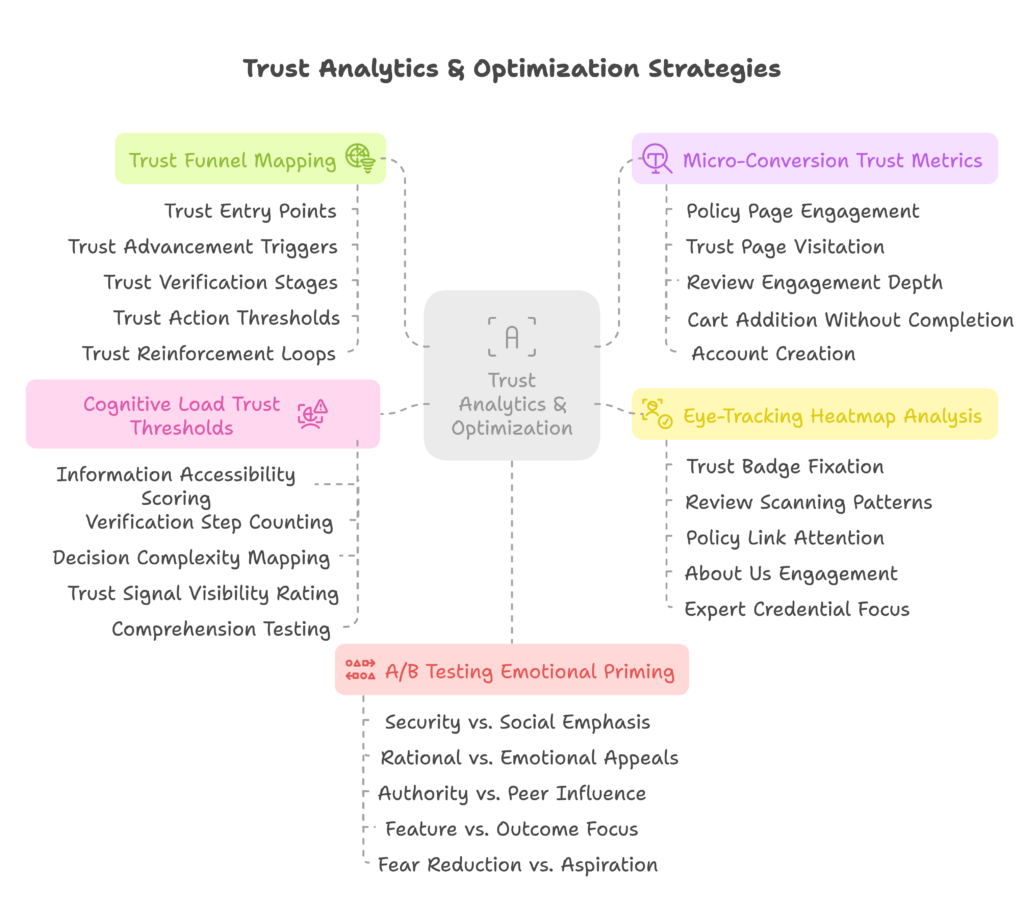
Trust Funnel Mapping
Visualizing the trust journey reveals optimization opportunities:
- Trust entry points: First touchpoints that establish baseline trust
- Trust advancement triggers: Elements that deepen confidence
- Trust verification stages: Points where customers actively assess credibility
- Trust action thresholds: Moments when sufficient trust enables conversions
- Trust reinforcement loops: Post-purchase experiences that strengthen trust
By mapping this journey, you can identify specific weaknesses in your trust pipeline and prioritize improvements where they’ll have maximum impact.
Micro-Conversion Trust Metrics
Small actions indicate growing trust before major conversions occur:
- Policy page engagement: Time spent reviewing terms, returns, etc.
- Trust page visitation: Interactions with about us, security info, etc.
- Review engagement depth: Detailed review reading behavior
- Cart addition without completion: Consideration without final commitment
- Account creation: Willingness to establish ongoing relationship
These micro-conversions serve as early indicators of trust development, allowing you to measure trust-building effectiveness before it impacts major conversion metrics.
Eye-Tracking Heatmap Analysis
Visual attention patterns reveal trust assessment behavior:
- Trust badge fixation: Time spent examining security/trust elements
- Review scanning patterns: How thoroughly users evaluate social proof
- Policy link attention: Notice given to terms, privacy, returns links
- About us engagement: Interest in company background
- Expert credential focus: Attention to authority indicators
Even without specialized eye-tracking equipment, mouse movement heatmaps can provide valuable insights into which trust elements receive attention and which are overlooked.
Cognitive Load Trust Thresholds
Measuring effort required for trust formation reveals friction points:
- Information accessibility scoring: How easily trust information is found
- Verification step counting: Number of actions to confirm claims
- Decision complexity mapping: Cognitive resources required for confidence
- Trust signal visibility rating: How readily trust elements are noticed
- Comprehension testing: How easily trust information is understood
The more mental effort required to establish trust, the fewer customers will complete the process. Minimizing this cognitive load increases trust formation rates.
A/B Testing Emotional Priming
Systematically testing trust triggers reveals customer-specific effectiveness:
- Security vs. social emphasis: Which trust category has greater impact
- Rational vs. emotional appeals: Which persuasion approach drives trust
- Authority vs. peer influence: Which validator type has more credibility
- Feature vs. outcome focus: Which presentation builds more confidence
- Fear reduction vs. aspiration: Which emotional driver creates trust
Different customer segments respond to different trust triggers. Systematic testing reveals which approaches work best for your specific audience.
As we look to the future, emerging technologies are creating new trust challenges and opportunities. Let’s explore what’s on the horizon.
Future-Proof Trust Architecture
Emerging technologies are transforming how trust is built and verified. This section explores cutting-edge approaches to stay ahead of trust evolution.
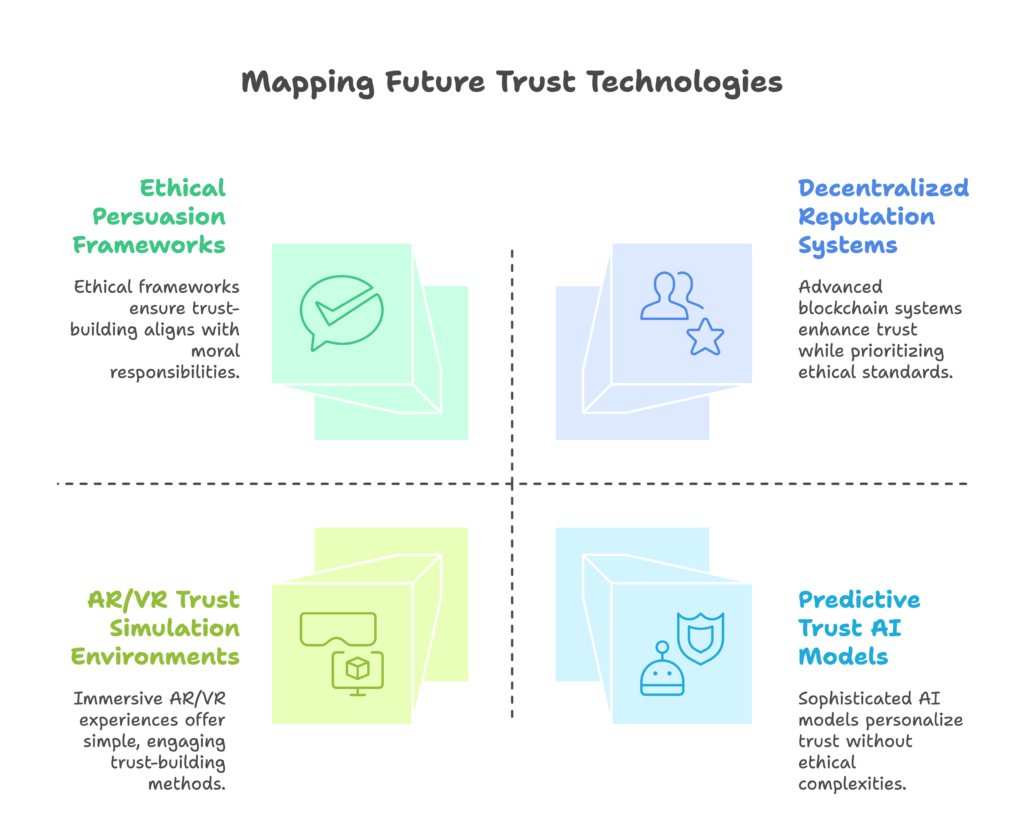
AR/VR Trust Simulation Environments
Immersive technologies create new trust-building opportunities:
- Virtual product testing: Try-before-you-buy in simulated environments
- Immersive brand experiences: Deep engagement with company values and culture
- 3D product visualization: Detailed examination from all angles
- Virtual store exploration: Engaging shopping experiences beyond flat pages
- Guided VR product demonstrations: Expert-led immersive product tours
As these technologies become more accessible, they bridge the trust gap created by inability to physically interact with products before purchase.
Neuro-Linguistic Trust Programming
Advanced language processing creates more trustworthy communications:
- Cognitive bias accommodation: Language tailored to mental shortcuts
- Trust signal vocabulary optimization: Words that trigger confidence
- Cultural trust marker adaptation: Region-specific trust indicators
- Transparency language frameworks: Communication patterns that signal honesty
- Cognitive fluency enhancement: Language that reduces mental processing effort
As AI writing tools evolve, they can help craft communications that naturally align with how the human brain evaluates trustworthiness across different contexts and cultures.
Predictive Trust AI Models
Machine learning systems that anticipate trust requirements:
- Trust deficit prediction: Identifying where customers likely need reassurance
- Personalized trust signaling: Custom trust elements based on behavior
- Trust threshold detection: Identifying when sufficient trust is established
- Context-aware trust emphasis: Adapting trust focus to purchase situation
- Risk tolerance mapping: Matching trust signals to personal risk appetite
These systems move beyond one-size-fits-all trust building to deliver personalized reassurance based on each customer’s specific concerns and behavioral patterns.
Decentralized Reputation Systems
Blockchain and distributed technologies creating new trust infrastructures:
- Portable customer reviews: User-owned feedback that travels across platforms
- Cross-platform reputation scoring: Aggregated trustworthiness metrics
- Tokenized trust incentives: Rewards for trust-building behaviors
- Smart contract guarantees: Automated enforcement of commitments
- Distributed verification networks: Crowd-validated authenticity checks
These systems reduce platform dependence and create more resilient, user-controlled trust mechanisms that better reflect real-world reputation building.
Ethical Persuasion Frameworks
Balancing effective trust building with ethical responsibility:
- Transparency gradients: Appropriate disclosure based on impact
- Autonomy preservation: Maintaining customer choice while building trust
- Authentic alignment protocols: Ensuring trust signals match reality
- Trust accessibility standards: Making trust verification available to all
- Persuasion ethics auditing: Systematic review of trust-building practices
As trust engineering becomes more sophisticated, ethical frameworks ensure these tools are used to create genuine trust based on real value, not manipulation.
Building e-commerce trust isn’t a one-time task but an ongoing process of improvement, measurement, and adaptation. By implementing the strategies in this blueprint, you’ll create a foundation of trust that translates directly into higher conversion rates, customer loyalty, and sustainable growth.
Ready to put these trust-building strategies into action? Shopify store owners can streamline many of these processes with Growth Suite – the all-in-one app for building trust signals, optimizing social proof, and creating authority indicators that convert visitors into loyal customers.
Must-Reads
The Science of Authority: Building Credibility in Your E-commerce Store
Social Proof 2.0: Beyond Reviews to Real-Time Social Signals
Trust Signals: The Complete Hierarchy from Basic to Advanced
References
- Cialdini, R.B. (2021). Pre-Suasion: A Revolutionary Way to Influence and Persuade. Simon & Schuster. https://www.simonandschuster.com/books/Pre-Suasion/Robert-Cialdini/9781501109805
- Edelman Trust Barometer (2025). Global E-commerce Trust Index. https://www.edelman.com/trust/2025-ecommerce-trust-report
- Das, A. (2018). Role of Familiarity and Trust on Purchase Behaviour. Great Lakes Herald. https://www.greatlakes.edu.in/herald/pdfs/sept-2018/Article-2.pdf
- Kwahk, K-Y. et al. (2012). Effects of Instant Messaging on Purchase Intention. APJIS. https://apjis.or.kr/pdf/MIS022-002-1.pdf
- Manning, K.C. & Sprott, D.E. (2009). Price Endings and Perceived Value. Journal of Consumer Research.
- Baymard Institute (2025). Trust Signal Optimization Guide. https://baymard.com/trust-signals
- Nielsen Norman Group (2024). E-commerce Credibility Patterns. https://www.nngroup.com/reports/ecommerce-credibility
- SEO.AI (2025). Trust Engineering Handbook. https://seo.ai/blog/how-to-build-trust-in-ecommerce
- ConvertCart (2024). Social Proof Implementation Framework. https://www.convertcart.com/blog/what-is-social-proof
- Connection Model (2025). Social Proof Systems Design. https://www.connectionmodel.com/blog/the-role-of-social-proof
- PCI Security Standards Council (2025). E-commerce Security Guidelines.
- W3C (2024). Transparency Protocol Standards.
- ISO 37001:2025 Anti-Bribery Management Systems.



[…] forget to check Building Trust & Authority in E-commerce: The Credibility Blueprint […]
[…] don’t forget to check Building Trust & Authority in E-commerce: The Credibility Blueprint […]
[…] don’t forget to check Building Trust & Authority in E-commerce: The Credibility Blueprint […]